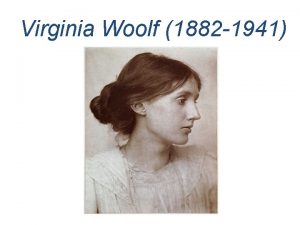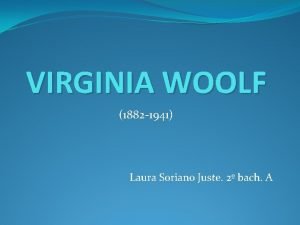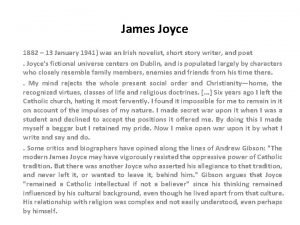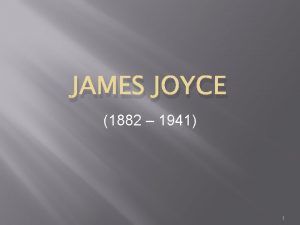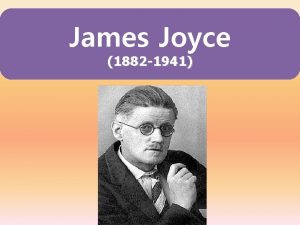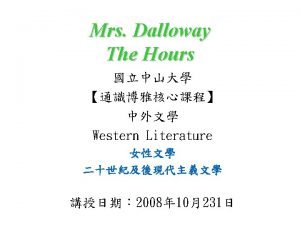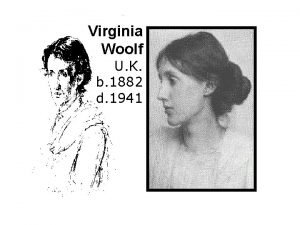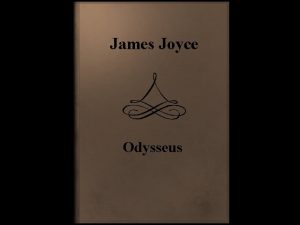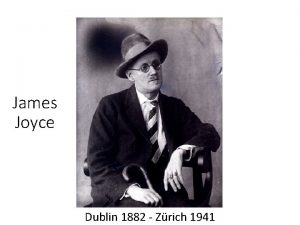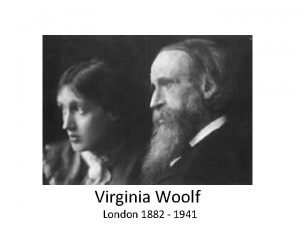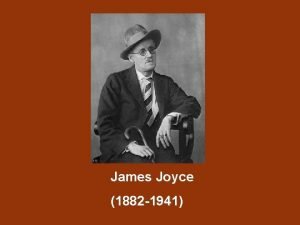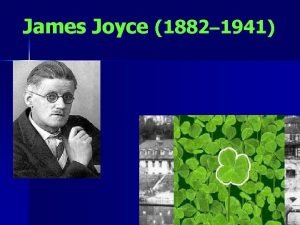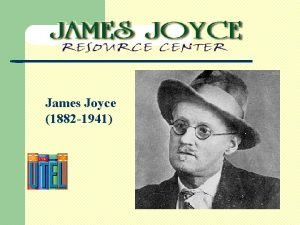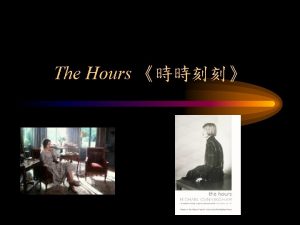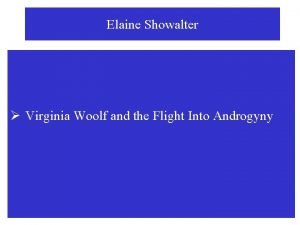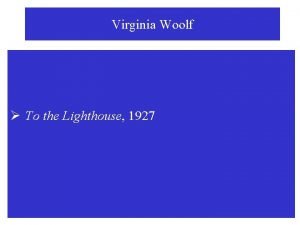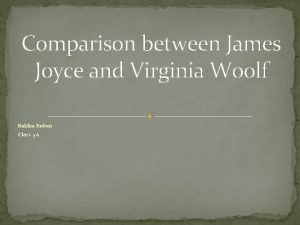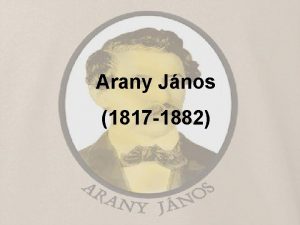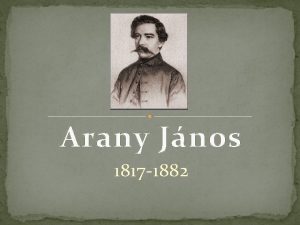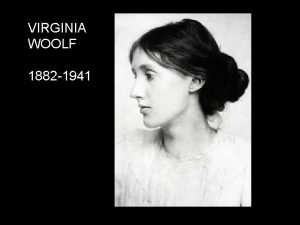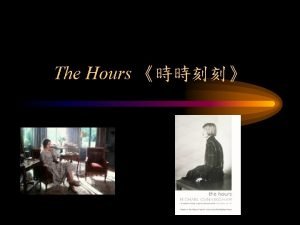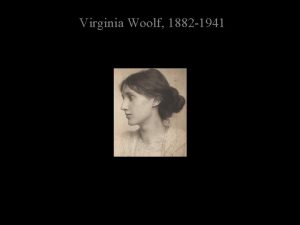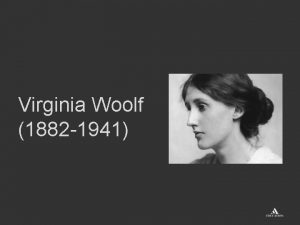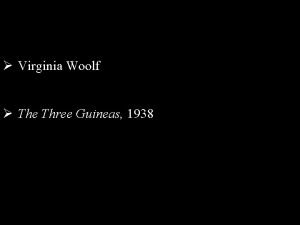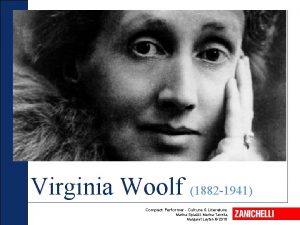Virginia Woolf 1882 1941 Her father Leslie Stephen






































- Slides: 38

Virginia Woolf (1882 -1941)

• Her father Leslie Stephen was an eminent Victorian man of letters. • She grew up in a literary and intellectual atmosphere with free access to her father’s library. • Childhood experiences of death and sexual abuse led to depression. Her stepbrother The death of her mother when she was 13. Two years later of her step-sister Stella

Suicide • After her father’s death, in 1904, she attempted suicide. • The Second World War increased her anxiety and fears. After a period of depression, she put rocks into her pockets and drowned herself in the River Ouse.

Literary career The Bloomsbury Group In 1904 she moved to Bloomsbury and became a member of the Bloomsbury Group. This meant the rejection of traditional morality and artistic convention. Experimentation best known as one of the great experimental novelists during the modernist period. The Bloomsbury Group: Auberon Duckworth; Duncan Grant; Julian Bell; Leonard Woolf. Front: Virginia Woolf; Lady Margaret Duckworth; Clive Bell; Vanessa Bell .

Evolution of her style in her main novels • The Voyage Out (1915) • Night and Day (1917) • Jacob’s room (1922) • Mrs. Dalloway (1925) • To the Lighthouse (1927) Traditional narratives Narrative experimentation with the novel A more completely developed “stream -of-consciousness technique”

A modernist novelist • Main aim to give voice to the complex inner world of feeling and memory. • The human personality a continuous shift of impressions and emotions. • Narrator disappearance of the omniscient narrator. • Point of view shifted inside the characters’ minds through flashbacks, associations of ideas, momentary impressions presented as a continuous flow. Vanessa Bell, Mrs St John Hutchinson, 1915, Tate Gallery, London

Stream-of-consciousness vs traditional technique Stream-ofconsciousness technique The action or plot is revealed through the mental processes of the character Character development is achieved through revelation of extremely personal thoughts Traditional technique …through the commentary of an omniscient narrator …through dialogue or the narrator’s description

Stream-of-consciousness vs traditional technique Stream-ofconsciousness technique The action of the plot moves back and forth through present time to memories of past events and dreams of the future. Dramatic monologue and free association Traditional technique …corresponds to real, chronological time Narration, description, dialogue and commentary by the narrator

Woolf vs Joyce Woolf’s stream of consciousness Joyce’s stream of consciousness never lets her characters’ thoughts flow without control, maintains logical and grammatical organisation characters show their thoughts directly through interior monologue, sometimes in an incoherent and syntactically unorthodox way

Woolf vs Joyce Moments of being Epiphanies Rare moments of insight during the characters’ daily life when they can see reality behind appearances. They can see something which was before hidden in the darkness of the consciousness The sudden spiritual manifestation caused by a trivial gesture, an external object the character is led to a self-realization about himself/herself

« Examine for a moment an ordinary mind on an ordinary day. The mind receives a myriad of impressions trivial, fantastic, evanescent or engraved in the sharpness of steel. From all sides they come, an incessant shower of innumerable atoms; and as they fall, as they shape themselves into the life of Monday or Tuesday , the accent falls differently…Life is not a series of lamps symmetrically arranged, Life is a semi-transparent envelope surrounding us from the beginning of consciousness to the end»

Mrs Dalloway (1925) (The Hours) • The main character, Clarissa Dalloway, is a wealthy woman • She spends her day ( June 1923) preparing for her evening party. She recalls her life before World War I, her possessive father, before her marriage to Richard Dalloway, and her relationship with Peter Walsh. • Septimus Smith is a shell-shocked veteran, one of the first Englishmen to enlist in the war. He is married to Lucrezia, an Italian woman. • The climax is Clarissa’s party: it gathers all the people Clarissa thinks about during the day. It is at the party that Dr Bradshaw, the nerve specialist, speaks about Septimus’s suicide.

• The news of Septimus ‘s suicide shocked the protagonist at the idea of death intruding into her successful social meeting • It is a powerful moment of being: she has always felt isolated, she feels how it is difficult to communicate with others, • But now she understands she has to accept herself and her life

Mrs Dalloway: setting • Set on a single ordinary day in June 1923. • It follows the protagonist through a very small area of London. • The characters enjoy the sights and sounds of London, its parks, its changing life. • Through what Woolf defined as the ‘tunnelling technique’, she allows the reader to experience the characters’ recollection of their past sense of their background and personal history. • Clarissa Dalloway’s party is the climax of the novel. Performer - Culture & Literature Mrs Dalloway’s walk from Dean’s Yard, Westminster, to Bond Street.

Mrs Dalloway: a changing society Significant changes in the social life of the time represented in the novel: • the spread of newspapers • the increasing use of cars and planes • the new standards in the marital relationship • the success of the cinema A motif the striking of Big Ben and of clocks in general A structural connection and a symbol

Mrs Dalloway: characters MRS DALLOWAY • She is fifty-one • The wife of a Conservative MP, Richard Dalloway, who has conventional views on politics and women’s rights. She experienced: • the influence of a possessive father, • the frustration of a genuine love, the need to refuse Peter Walsh, a man who would force her to share everything. Vanessa Redgrave as Mrs Dalloway. All this has weakened her emotional self. Performer - Culture & Literature

She is characterised by opposing feelings: Her need for freedom and independence Her class consciousness To overcome her weakness and sense of failure, she imposes severe restrictions on her spontaneous feelings.

SEPTIMUS WARREN SMITH • An extremely sensitive man. A young poet and lover of Shakespeare. • When the war broke out, enlisted for patriotic reasons. • He can suddenly fall prey to panic and fear, or feelings of guilt for the death of his best friend, Evans, during the war. • He is a ‘shell-shock’ case, • He is haunted by the spectre of Evans, he suffers from headaches and insomnia. • He cannot stand the idea of having a child, he is sexually impotent. Actor Rupert Graves plays the role of Septimus Warren Smith in the 1997 film ‘Mrs Dalloway’.

• • MRS DALLOWAY She responds to experience in physical terms. She depends upon her husband for stability and protection. She never loses her awareness of the outside world as something external to herself. She finally recognises her deceptions, accepts old age and the idea of death, and is ready to go on. • • SEPTIMUS SMITH He responds to experience in physical terms. He depends upon his wife for stability and protection. He is not always able to distinguish between his personal response and the nature of external reality. His psychic paralysis leads him to suicide.

To the Lighthouse (1927) No traditional plot a series of experiences, memories, emotions and feelings held together by symbols. The story develops over a period of ten years. Divided into three sections: 1. The Window It starts just before World War I. It is set during a summer afternoon and evening in a summer home on the Isle of Skye in the Hebrides. The Ramsays are there with their 8 children and some guests The original St. Ives lighthouse, built by John Smeaton in 1830.

2. Time Passes covers about ten years. The children grow up, war breaks out, Mrs Ramsay dies suddenly one night. Her eldest son, Andrew, is killed in battle, and her daughter Prue dies too. The summerhouse falls into a state of decay for ten years until the family comes back. The original St. Ives lighthouse, built by John Smeaton in 1830.

3. The Lighthouse lasts less than one day. Inner time experienced and recaptured in memory, replaces outer time. Mr Ramsay, his son James and his daughter Cam sail to the lighthouse. Lily succeeds in finishing her painting. The original St. Ives lighthouse, built by John Smeaton in 1830.

the characters • They all reflect her own unusual personality or are modelled on people from her own close set of friends • They all belong to the upper middle class and share the same way of thinking • They don’t exixt as characters but only as a projection of the author’s mind

A tunnelling technique • To let the reader perceive something about the background and history of the characters through their own recollections and memories of the past

MRS RAMSAY • • A beautiful woman and loving wife, understanding, constantly provides support to the other characters in the novel. Her sensibility and intuition are the human qualities that give a person the power to illuminate our darkness as a lighthouse As a mother, her main objective is to preserve her son James’s sense of hope and wonder in relation to the lighthouse. She is the past, she is the tradition Vanessa Bell, Virginia Woolf at Asheham, ca. 1910, National Portrait Gallery, London.

MRS RAMSAY • She realizes that the beauty of this world is ephemeral and should be protected. • She has the ability to bring together different things into a whole. • After her death, Lily and the other characters try to reach this unity. Vanessa Bell, Virginia Woolf at Asheham, ca. 1910, National Portrait Gallery, London.

LILY BRISCOE • She is the present and future • Rejects the conventional image of the woman represented by Mrs Ramsay. • She replaces marriage with the devotion for her job Duncan Grant, Vanessa Bell painting, 1915, National Galleries of Scotland. • A painter who fears her work will end up in attics or under a couch. • Masculine

LILY BRISCOE • Her portrait of Mrs. Ramsay embodies her doubts: at the beginning of the novel she cannot make sense of the shapes and colours that she tries to reproduce. • Undergoes a drastic change evolving into an artist who achieves her final vision. “ A line in the middle of the picture” restores the balance Only at the end she is able to accept herself, her feminine side, she is able to understand the others and feel sympathy «I need 50 pairs of eyes to understand Mrs Ramsay» ………… «Nothing stays, all changes, but not words , not paint»

To the Lighthouse: themes a. Transience the idea that nothing lasts runs through the novel § Mrs Ramsay does not want her children to become adults. § The house falls into decay. § Death unexpectedly ends life. St. Ives, Cornwall, the setting for The Lighthouse

b. Loss § Minta loses her brooch on the beach. § The family loses some of its members. St. Ives, Cornwall, the setting for The Lighthouse

c. d. Art the ambition to stop the passing of time is embodied by the artist Lily Briscoe. The force of love Mrs Ramsay believes that also love can create durable memories making moments permanent. St. Ives, Cornwall, the setting for The Lighthouse

Symbolism The sound of the sea the fullness of life and the imminence of death, uncertainty. With its ebbing and flowing tides, its waves lapping on the beach , it is now consoling and protective , now destructive. A scene from 2002’s The Hours, directed by Stephen Daldry. It stands for Life itself and for the flow of time

The alternation between darkness and light in the flow of life The division in three parts reproduces the beams of light from the lighthouse : • a long one • a pause of darkness • another beam of light The lighthouse and the journey are the unifying factors between the initial and final scenes of the novel

The lighthouse “ Nothing is simply one thing” • a positive symbol linked to light, comfort, hope and enthusiasm, a dream, an achievement, a reference point in a changing world. BUT also • the inaccessible destination leading to frustration. • loneliness • Indifference A symbol of eternity, joy and sorrow

The window the dividing and connecting point between the self and society. • We look out of the window of a train and see for a brief moment a group of figures conveying their own minds and memories The land the house idea of shelter and stability. At the end of the first part the wind enters and asks : « Will you fade? Will you perish? » And the objects « we remain»

Dearest, You can’t think how I loved your letter. But I feel I have gone too far this time to come back again. I am certain now that I am going mad again. It is just as it was the first time, I am always hearing voices, and I shan’t get over it now. All I want to say is that Leonard has been so astonishingly good, every day, always; I can’t imagine that anyone could have done more for me than he has. We have been perfectly happy until these last few weeks, when this horror began. Will you assure him of this? I feel he has so much to do that he will go on, better without me, and you will help him. I can hardly think clearly anymore. If I could I would tell you what you and the children have meant to me. I think you know. I have fought against it, but I can’t any longer. Virginia. ”


I feel certain I am going mad again. I feel we can’t go through another of those terrible times. And I shan’t recover this time. I begin to hear voices, and I can’t concentrate. So I am doing what seems the best thing to do. You have given me the greatest possible happiness. You have been in every way all that anyone could be. I don’t think two people could have been happier till this terrible disease came. I can’t fight any longer. I know that I am spoiling your life, that without me you could work. And you will I know. You see I can’t even write this properly. I can’t read. What I want to say is I owe all the happiness of my life to you. You have been entirely patient with me and incredibly good. I want to say that — everybody knows it. If anybody could have saved me it would have been you. Everything has gone from me but the certainty of your goodness. I can’t go on spoiling your life any longer. I don’t think two people could have been happier than we have been.
 Tunneling technique woolf
Tunneling technique woolf 1941-1882
1941-1882 1941-1882
1941-1882 1882-1941
1882-1941 Mrs dalloway setting
Mrs dalloway setting 1941-1882
1941-1882 1941-1882
1941-1882 Introducing james joyce
Introducing james joyce 1941-1882
1941-1882 1941-1882
1941-1882 Giorgio joyce
Giorgio joyce 1941-1882
1941-1882 1941-1882
1941-1882 1941-1882
1941-1882 1941-1882
1941-1882 1941-1882
1941-1882 Mrs dalloway summary
Mrs dalloway summary Virginia woolf family tree
Virginia woolf family tree Lady in the looking glass summary
Lady in the looking glass summary A haunted house by virginia woolf characters
A haunted house by virginia woolf characters Virginia woolf
Virginia woolf Who's afraid of virginia woolf as an absurd play
Who's afraid of virginia woolf as an absurd play Virginia woolf characteristics
Virginia woolf characteristics Who's afraid of virginia woolf themes
Who's afraid of virginia woolf themes Virginaia woolf
Virginaia woolf Who's afraid of virginia woolf themes
Who's afraid of virginia woolf themes Virginaia woolf
Virginaia woolf To the lighthouse (1927)
To the lighthouse (1927) Virginia woolf on james joyce
Virginia woolf on james joyce Leslie has 1 liter of milk in her refrigerator
Leslie has 1 liter of milk in her refrigerator Seo northern virginia virginia
Seo northern virginia virginia Re german date coffee co
Re german date coffee co Loi du 28 mars 1882
Loi du 28 mars 1882 1882 triplice alleanza
1882 triplice alleanza 1817 1882
1817 1882 1817-1882
1817-1882 Georges braque (1882-1963)
Georges braque (1882-1963) 1817-1882
1817-1882 Loi du 28 mars 1882
Loi du 28 mars 1882
